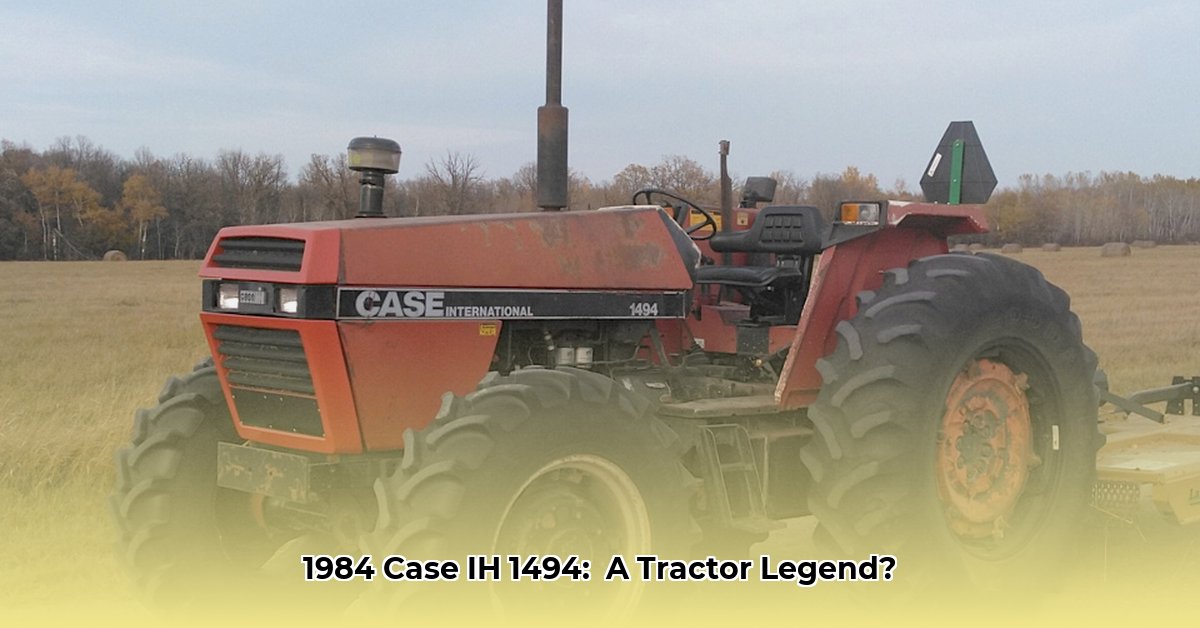
The Case IH 1494: A Workhorse of the 1980s
The Case IH 1494 tractor, a mainstay of the 1980s agricultural landscape, represents more than just a machine; it embodies the farming practices and technological advancements of its era. This detailed retrospective review explores its technical specifications, historical context, market impact, sustainability considerations, and collector's value. Understanding its design choices reveals much about the challenges and priorities of farmers during that time. Were these tractors truly sustainable by modern standards? Let's investigate. For more on Case tractors of this era, check out this great resource.
Technical Specifications and Performance
The Case IH 1494 boasted a robust 85-horsepower engine (a significant amount for its time), providing ample power for numerous farm tasks. Its 12-speed transmission, a blend of synchromesh and partial power shift gears, allowed for smooth and efficient operation across varied conditions. The tractor's hydraulic system, delivering a flow rate of 8.5 to 15.3 gallons per minute, supported a wide range of implements. This combination of power and versatility made the 1494 a capable asset to many farmers. But how did these features compare to modern standards?
Historical Context: The Agricultural Landscape of the 1980s
The 1980s presented a unique agricultural environment. While some farms were expanding, many remained smaller family operations. Fuel costs were a major factor, especially given fluctuating oil prices that directly impacted profitability. Precision agriculture, with its GPS and automation, was still largely a future prospect. The 1494, while not technologically advanced by today's standards, offered reliable power and durability, making it a suitable choice for the farming realities of that decade. How did this reliance on robust, simpler solutions shape the tractor's design?
Market Success and Production
Case IH produced a considerable number of 1494 tractors, with peak production likely between 1985 and 1988. This high production volume speaks to its market appeal. What factors drove its popularity? The combination of robust build quality, dependable performance, and relative affordability likely played crucial roles. The 1494 became a dependable partner for many farmers, and its legacy extends beyond mere sales figures, encompassing the personal experiences and contributions of those who used it. What did this success mean for Case IH's future design decisions?
Sustainability Assessment: A Retrospective View
Assessing the sustainability of the 1494 against modern standards requires nuance. Fuel efficiency wasn't a primary design consideration in the 1980s, and emission controls were far less stringent. However, the 1494's durability stands out. Many remain operational today, which highlights its robust build. The challenge now lies in maintenance and parts availability—restoration can demand considerable time and expense. This highlights a key trade-off: the long life span of the 1494 offsets the lower fuel efficiency and relative lack of consideration for emissions common in its era.
Collector's Value and Preservation
Today, the 1494 has attracted interest from collectors of vintage farm equipment. Its value depends on various factors, including its condition, originality, and any accompanying documentation. A well-preserved, original 1494 in excellent working order fetches a significantly higher price than one in need of restoration. The growing interest in vintage tractors suggests that this machine will continue to hold value for years to come. What factors contribute most to a 1494's collector value?
Conclusion: A Lasting Legacy
The Case IH 1494 tractor holds a significant place in agricultural history. While its design reflects the priorities of its time—durability and power—its story also reveals the evolution of farm machinery. Its legacy extends beyond its technical specifications; it reflects the challenges and triumphs of the farmers who relied on it. Its lasting presence among collectors and enthusiasts underscores its enduring impact on the agricultural landscape.
Key Features at a Glance:
| Feature | Specification |
|---|---|
| Engine Horsepower | 85 hp |
| Transmission | 12-speed (synchromesh & power shift) |
| Hydraulic System | 8.5-15.3 gpm flow |
| Production Years | Approximately 1983-1988 |
Three Pivotal Points:
- The 1494's robust design and reliable performance made it a popular choice for 1980s farmers.
- While not fuel-efficient by today's standards, its durability and longevity are remarkable.
- Its collector value and continued interest highlight its enduring significance in agricultural history.